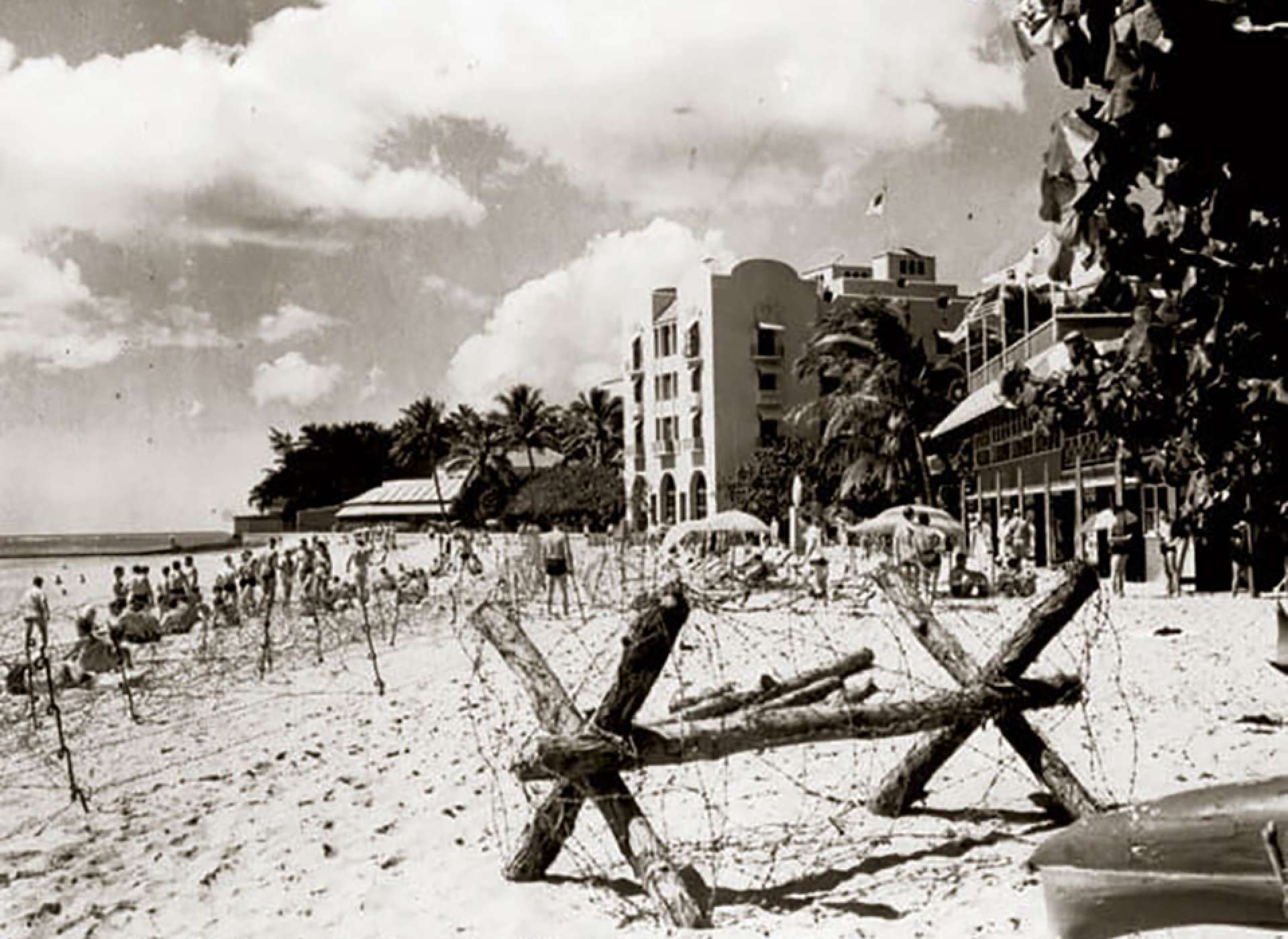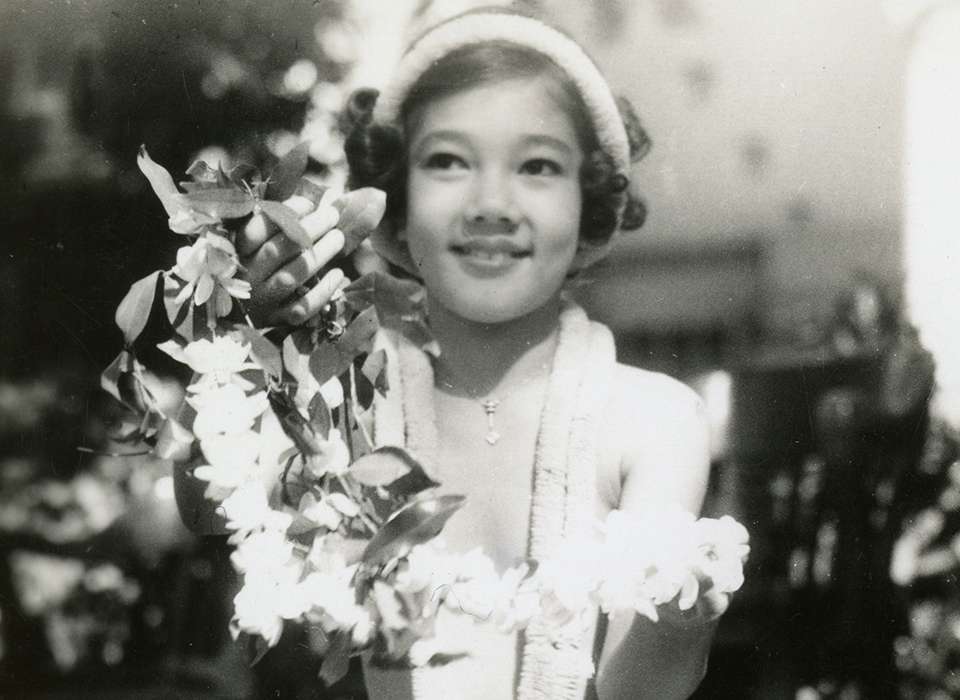Top Image: A Hawaiian girl poses with a Lei in Hawaii, June 1941. “From George—June 1941—Hawaii.” The National WWII Museum, Gift of Jane Dickman Schlaht, 2011.124.150.
On the morning of December 7, 1941, a young girl living on the Island of Oahu was up early—much earlier than normal for the nine year old. She was busy fixing a surprise breakfast of cereal, papaya, and Portuguese doughnuts (malasadas) for her mother, father, and two siblings, and gathering fresh flowers from her neighbor’s garden when a rumbling overhead made her stop and look toward the sky. She’d grown used to planes zooming over her house in Honolulu to and from the US Army’s Hickam Field near the Pearl Harbor naval base, but she knew something was different this time, something wasn’t quite right.
The planes were flying much lower than usual, and it was only when she caught a glimpse of the “round, red sun” on the tail of one of the planes that she realized these weren’t Americans practicing maneuvers; these were Japanese planes. Moments later, black plumes of smoke filled the sky over Wheeler Airfield, making the girl freeze, her teeth chattering in fear.
By 8:35 a.m., she and her mother, brother, and sister gathered around the radio in their living room listening to the latest announcement:
“This is no maneuver. This is the real McCoy. Enemy airplanes have attacked.”
The breakfast and flowers forgotten, the young girl realized that the talk she’s heard for months among the grown-ups around the kitchen table about negotiations with Japan had somehow led to this, her home under attack. The attack on Pearl Harbor changed Nanea’s life, as it would for other children in America, but Nanea’s story was characterized by curfews, blackouts, air raids, and censorship under martial law.
Nanea’s account provides a child’s view of life during the early months of America’s entrance into World War II, but Nanea wasn’t real. She’s a fictional character, introduced in 2017 by the beloved American Girl company that has provided children with insights into key historic moments and eras through short, historically-grounded books and accompanying dolls since 1986.
Alice Nanea Mitchell—a young girl born to a Hawaiian mother and white father who works at the Pearl Harbor shipyard as a welder—is not the company’s first character to bring to life the story of the American home front during World War II. Molly McIntire, released as one of the original American Girl characters in 1986, was a 10 year old girl navigating life without her father (who was serving overseas) in Illinois, and grappling with rationing and fear for her family during the war. Despite her fictional status, however, Nanea offers young and older readers alike a unique, yet relatable, story of growing up during a war and confronting social changes including martial law, discrimination, and loss in addition to the everyday struggles of kids to find their place in the world.
The first book in Nanea’s series, The Spirit of Aloha, establishes her character, the people who mean the most to her, and her life in Hawaii. Nanea is eager to prove to her family—especially her older sister, Mary Lou, and 17 year old brother, David—that though the youngest, she can take on more responsibilities, such as working at her grandparents’ store. Nanea learns of the Honolulu Helping Hands contest in her local paper (skipping over the “war stories” that describe in detail the growing tensions between the United States and Japan) that requires four selfless deeds completed before December 15 in order to win a bike—exactly what Nanea needs to prove her maturity. Nanea and her two friends, Donna, a white girl who moved with her family from California for her father’s work at Pearl Harbor, and Lily, a Japanese American girl, form the Hawaiian Helpers and set about making and handing out leis to visitors and thinking of ways to show appreciation to family and friends.
Nanea is in the middle of her third good deed—making breakfast for her family—when Japanese planes attack Pearl Harbor. Author Kirby Larson’s descriptions through Nanea’s eyes are vivid and encapsulate the confusion for children who experienced the attack and the moments immediately following. Nanea’s father volunteers to go to the shipyard to help assess damages even though he is a civilian and therefore not “military essential,” while Nanea, her mother and siblings, and their neighbors try to make sense of rumors of a Japanese invasion—filling tubs with water in case Japanese disrupt supplies and remaining indoors despite wanting to check in on family and loved ones—after radio service is lost.
American Girl researchers turned to Dorinda Makanaonalani Nicholson for a true account of a child’s view of the Pearl Harbor attack. Many of the details of Nicholson’s life are similar to those of Nanea. Nicholson, born to a native Hawaiian mother and white father, recounted her experiences as a young girl living on Pearl City Peninsula (only a few hundred yards from the USS Utah) in her book Pearl Harbor Child: A Child’s Eye-Witness View from Attack to Peace, and the attack on the harbor. She remembered “[clinging] to her father’s side as enemy torpedo bombers screamed overhead, skimming the treetops.” Elements of Nicholson’s memories are seen throughout Nanea’s story.
For nights following the attack, Nanea is haunted by visions of smoke and the sounds of attacking planes. She often feels crushing anxiety of another looming attack and simple thumps and thuds like the newspaper being delivered send her shivering and cowering. During the “fifth night without [her] Papa” when he is still needed at the shipyard, Nanea remembers “the ‘before’ night sky” with “soft, twinkling stars,” and compares it with the “‘after’ nighttime [which] is sharp and lonely.”
The months following the Pearl Harbor attack aren’t any easier for Nanea. The Spirit of Aloha highlights the pressures of living under martial law. Hours after the attack, General Walter Short (appointed military governor by Governor John Poindexter) declared martial law in Hawaii which is also an important part of Nanea’s fictional experiences. Nanea encounters curfews, blackouts, and censorship of reading materials as residents of Hawaii did at the time. She’s also perpetually worried about her old brother, David, who is eager to join the Army despite her mother’s concern. But Nanea also learns that her experience is much different from those of her close friends.
Donna and her mother, who are civilians and not “military essential,” are sent back to the mainland as many others were at the time; as nonessential, they would be a strain on Hawaii’s resources, despite her attempts to prove that she was essential through volunteer warwork. Lily, as a Japanese American girl, witnesses her father being taken away by the FBI in the middle of the night. Because of their race, Lily and her family are suspected of being disloyal to the United States and continue to encounter discrimination on the island, challenging Nanea’s love of the racial and ethnic diversity of her home.

Barbed Wire on Waikiki Beach. Courtesy of National Archives and Records Administration.
Things look bleak for Nanea, but the second book in her series, Hula for the Home Front, follows her attempts to work with her ‘ohana (family) to support the war effort and maintain a sense of normalcy amidst the chaos around her. Nanea’s culture factors prominently in Hula for the Homefront, and it is often her cherished traditions that allow her to navigate her wartime world. She uses her love of hula to perform for the USO and even trains her dog, Mele, to perform with her—raising the spirits of the men stationed in Hawaii. She works with friends from school to collect bottles and other materials necessary for the war effort in the tradition of kokua, or good deeds done without the expectation of praise from others.
Family events, like her brother’s birthday luau, comforted her as they did for other children during the war. Nanea loves the traditional foods served at these parties but more importantly, she “especially loved knowing that people in her ‘ohana had been celebrating like this since she didn’t even know when.” Author Kirby Larson worked closely with an advisory board consisting of five native Hawaiian scholars (including Nicholson) to incorporate elements of Hawaiian culture into Nanea’s story.
The final deed for Nanea to win the Helping Hands challenge is to “turn trouble into triumph.” When the contest was first announced, this was a confusing task, but, by the end of Hula for the Home Front, Nanea knows exactly how to accomplish this through her dedication to community service, ‘ohana, and tradition. As her brother David explains after Nanea laments that “there are too many problems and all of them are too big,” “You don’t have to face this alone. Your ‘ohana, your family, is here with you.”
A constant theme throughout Nanea’s books is the recognition that war is not just a “grown-up” issue. When Lily confides in Nanea that she’s been having a hard time sleeping because of the mandated blackouts, Nanea agrees. “The grown-ups tell us not to worry, but how can we help it?” she asks, recognizing the shrinking space between her childhood and what comes next in the war. Nanea’s tutu, or grandmother, also understands. “This war has been hardest on you children,” she explains to Nanea. “You don’t deserve such grown-up worries.”
Nanea’s story is a window into what life was like growing up in Hawaii after Pearl Harbor and though her books do not cover the entirety of the war, they’re a reminder of how World War II changed the lives of children in ways big and small.
Stephanie Hinnershitz, PhD
Stephanie Hinnershitz is a historian of twentieth century US history with a focus on the Home Front and civil-military relations during World War II.
Cite this article:
MLA Citation:
APA Citation:
Chicago Style Citation:






![Max Fuchs, New York City cantor, sings as Rabbi Sydney [sic] Lefkowitz, Richmond, VA, conducts the first Jewish services from Germany.](/sites/default/files/styles/max_650x650/public/2025-10/image1.jpg)


